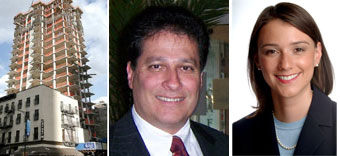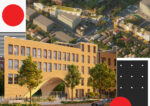
From left, 303 East 51st Street, Ziel Feldman, founder of HFZ Capital
Group, and City Council member Jessica Lappin
For three and a half years, the structure at 303 East 51st Street has remained a stunted
skeleton, halted at 18 stories after the infamous March 2008 crane collapse that killed
seven people and crushed an adjacent building.
But that may change soon.
Ziel Feldman, founder of HFZ Capital Group, which closed on the purchase of the site
early this year, said through a spokesperson that he would have “significant progress to
announce” later this week, and the firm plans to restart construction at the site, on 51st
Street between First and Second avenues, this spring.
The expeditor on the project, Laurence Gillman, an associate at Jerome S. Gillman
Consulting Architect, said that the Department of Buildings had completed its zoning
examination of the plan and was reviewing architectural and other drawings as part of a
building code review.
“We anticipate this review to be completed and satisfied in the near future, with a
permit issued shortly thereafter,” Gillman told HFZ in a letter dated the day after a
reporter inquired about the site.
HFZ’s plans for the site call for a 32-story tower with a mix of 115 studios and one-,
two-, three- and four-bedroom units ranging from 700 to 5,500 square feet and priced at
more than $1,600 per square foot, with an emphasis on larger units. The tower will also
have 10,348 square feet of ground-floor retail space, a 60-space underground parking
garage, a fitness club and a pool.
As of Oct. 6, however, “no new plans have been approved for the site,” said Ryan
Fitzgibbon, a spokesperson for DOB, declining to comment further.
And with an 18-story tower already partially built on the closely watched site, the
property is a tricky one, sources said, particularly since a new building code took effect
after the crane incident.
As of right
HFZ’s involvement with the property dates back to October 2009, when the firm agreed
to pay $38 million to acquire the note on the building from lender Arbor Realty Funding,
which had foreclosed on the site’s original owner, Kennelly Development. Kennelly
paid $3.25 million for the first parcel of land there in 2004, according to city records. A
spokesperson for Arbor declined to comment because they are no longer involved with
the property.
Three months after the accident in 2008, DOB revoked Kennelly’s building permit
because the project reportedly never complied with zoning requirements — a revelation
that ultimately contributed to the resignation of then DOB Commissioner Patricia Lancaster, as well as bribery charges filed against another department official.
Kennelly did not respond to a request for comment.
As The Real Deal previously reported, the tower’s remaining floors were expected to
be completed in the spring of 2011, and HFZ planned to invest $60 million to complete
construction.
In June, DOB disapproved the most recent examination of the plan, filed last December
by the Jerome S. Gillman firm and the architects on the project, SLCE Architects, records
show. Major buildings routinely receive multiple disapprovals as the agency completes
the examination process, Laurence Gillman noted. DOB wouldn’t say why it did not
approve the plan.
City Council member Jessica Lappin, who represents the area, said when she met with
HFZ representatives in December, they told her their aim is to use the existing structure
and build “as of right,” that is, without seeking a zoning variance. A spokesperson for the
Department of City Planning confirmed that no one had applied for a variance at 303 East
51st Street.
In October 2010, HFZ bought the corner lot on Second Avenue at 51st Street, enlarging
the total parcel of land available for the tower, according to city records.
That larger plot will make it easier to build a tower-on-base structure, Lappin said. Plus,
she added, HFZ said in December it would have to remove the existing balconies and a
slice of the east side of the building to comply with zoning rules.
Building code issues?
But another complication, according to a source with intimate knowledge of the project,
is that the development is no longer grandfathered under New York’s now defunct
building code, since the original permit was revoked.
The code, which took effect July 1, 2008, requires developers to install wider stairwells
and larger elevators, among other changes. At 303 East 51st Street, those components are
already poured into concrete up to 18 stories, meaning the standing structure isn’t up to
the current code, the source said.
Theoretically, HFZ could still take advantage of the prior regulations, said Richard
Lambeck, chair of the construction management program at the New York University
Schack Institute of Real Estate.
“The intention was that when the new building code came into existence, as long as
projects were being submitted prior to that, you could build under the old building code,”
he said, adding that the new rules were aimed more at high-rise commercial buildings,
rather than residential buildings.
HFZ said the planned building design has been updated to comply with today’s code,
with “exceptions” for the portion erected under the old code, thanks to DOB’s cooperation
and the use of NYC Development Hub, DOB’s recently launched digital program for
expediting development plans.
Attorney Barry LePatner, a noted construction industry expert, explained that HFZ
will have to convince DOB examiners that its planned tower is simply an extension to
the existing structure, as with other incomplete structures around the city — but that is
possible, he said.
However, because of the crane collapse, DOB is likely taking a closer look at what’s been
constructed at the site, particularly since the department has already revoked the permit,
Lambeck said.
Earlier this year, DOB granted Lappin’s request to treat documents submitted for the
site as new construction filings, rather than filings for an existing structure, giving the
community a 45-day window to object to the plan once it is approved, she said.
Lappin said she doesn’t anticipate objections from the community. Representatives from
the Turtle Bay Association neighborhood group and from local Community Board 6 did
not immediately respond to requests for comment.
Looking ahead
In March, HFZ received permission from the DOB to dismantle shoring posts and
structural work on the 18th floor, and someone reported to DOB that 25 workers were
doing construction on the property, according to city records.
Still, the progress at the site is a sharp contrast to the Azure at 333 East 91st Street, where
a crane collapse killed two people in May 2008. That condominium, where sales started
before the accident, was declared effective by the attorney general in June 2010, and is
now more than 40 percent sold.
Without an approved building plan, HFZ will have an uphill battle to obtain financing for
the project, sources said.
In this environment, any financial institution is going to want to see the details of a
project before forking over funding, Lambeck said. And if the building permit doesn’t
allow enough space to make money on the project, financing will be an issue, another
source said.
In January, HFZ secured a $22 million loan against rents and leases at the 51st Street
and Second Avenue lots, city records show. Chuck Rosenzweig, managing partner of the
private investment firm Criterion Real Estate Capital, whose signature appears on the
loan documents, declined to comment on the transaction.
But it’s clear that HFZ will need more to complete the project; it’s expected to cost more
than $231 million, including roughly $84 million for construction and $23.3 million in
financing costs, according to financial projections recently prepared by HFZ and obtained
by The Real Deal.
Still, Feldman has a good track record as a sponsor — backing projects like the Setai Wall Street, condos at 40 Broad Street and Hotel Thirty Thirty at 30 East 30th Street — and
probably has a plan to put the money together, a source said.
For its part, HFZ said financing “is not an issue.”
Feldman is the chair of Polar Investments, an Israeli public company that has a strategic
alliance with HFZ, and sources suggested he may tap the company as a funding source.
In September 2010, Polar Investments reported revenues of $40.6 million, up from $22.6
million in September 2009 — but did not post a profit. More recent financial statements
are not available, and since May, Polar stock has not budged from about $250.
As for HFZ’s assumptions on price per square foot, a source familiar with the deal said
that, “[Feldman’s] projections are aggressive for the current market” and “very optimistic”
for Turtle Bay.
Fabienne Lecole, a senior vice president at the Corcoran Group, acknowledged that the
prices were on the higher end for the neighborhood but, considering the luxury amenities
planned, were not unreasonable.
At 211 East 51 Street, a new 14-story development between Second and Third avenues,
11 sponsor units are priced at an average of $1,311 per square foot, according to Rena
Goldstein, a senior vice president at Halstead Property. But she noted that the 51st Street
building does not have the same kind of luxury amenities, such as a pool.
At Trump World Tower, at 845 United Nations Plaza, which Goldstein considered
the “head-to-head competition” for 303 East 51st Street, 28 units are on sale for an
average $1,805 per square foot.
“Because of its price point, [303 East 51st Street is] not going to appeal to everyone, but
there’ll be a market for it,” Goldstein said.
Plus, as Lepatner pointed out, “We all — the city, the buildings department and the rest
of us — have a vested interest in seeing these projects built out, and not left as rusting
hulks.”
Feldman largely declined to comment for this story.



